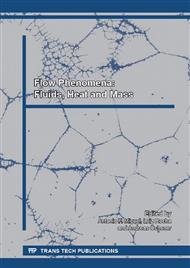[1]
S.B. Pope, Turbulent Flows, Cambridge University Press, (2008).
Google Scholar
[2]
D. C. Wilcox, Turbulence modeling for CFD, 2nd Ed., DCW Industries, La Canada, USA, (2002).
Google Scholar
[3]
M. Lesieur, O. Métais, P. Comte, Large-eddy simulations of turbulence, New York, USA, (2005).
DOI: 10.1017/cbo9780511755507
Google Scholar
[4]
P. Sagaut, Large eddy simulation for incompressible flows, an introduction, Springer Berlin Heidelberg, Berlin, Germany, (2006).
Google Scholar
[5]
N. Kasagi, O. Iida, Progress in Direct Numerical Simulation of Turbulent Heat Transfer, in: Proc. 5th ASMEJSME Jt. Therm. Eng. Conf., San Diego, 1999: pp.1-17.
Google Scholar
[6]
S. Schmidt, M. Breuer, Hybrid LES–URANS methodology for the prediction of non-equilibrium wall-bounded internal and external flows, Comput. Fluids. 96 (2014) 226–252. doi: 10. 1016/j. compfluid. 2014. 03. 020.
DOI: 10.1016/j.compfluid.2014.03.020
Google Scholar
[7]
E. D. dos Santos, G. L. Piccoli, F. H. R. França, A. P. Petry, Analysis of mixed convection in transient laminar and turbulent flows in driven cavities, Int. J. Heat Mass Transf. 54 (2011).
DOI: 10.1016/j.ijheatmasstransfer.2011.06.019
Google Scholar
[8]
A. Colleoni, A. Toutant, G. Olalde, Simulation of an innovative internal design of a plate solar receiver: comparison between RANS and LES results, Sol. Energy. 105 (2014) 732–741. doi: 10. 1016/j. solener. 2014. 04. 017.
DOI: 10.1016/j.solener.2014.04.017
Google Scholar
[9]
M. Caciolo, P. Stabat, D. Marchio, Numerical simulation of single-sided ventilation using RANS and LES and comparison with full-scale experiments, Build. Environ. 50 (2012) 202–213. doi: 10. 1016/j. buildenv. 2011. 10. 017.
DOI: 10.1016/j.buildenv.2011.10.017
Google Scholar
[10]
D. Bouris, G. Bergeles, 2D LES of vortex shedding from a square cylinder, J. Wind Eng. Ind. Aerodyn. 80 (1999) 31 – 46.
DOI: 10.1016/s0167-6105(98)00200-1
Google Scholar
[11]
S. Mazumder, M. F. Modest, A probability density function approach to modeling turbulence_radiation interactions in nonluminous flames, Int. J. Heat Mass Transf. 42 (1999) 971–991.
DOI: 10.1016/s0017-9310(98)00225-7
Google Scholar
[12]
G. Li, M.F. Modest, Importance of Turbulence-Radiation Interactions in Turbulent Diffusion Jet Flames, J. Heat Transf. 125 (2003) 831. doi: 10. 1115/1. 1597621.
DOI: 10.1115/1.1597621
Google Scholar
[13]
A. Wang, M.F. Modest, D.C. Haworth, L. Wang, Monte Carlo simulation of radiative heat transfer and turbulence interactions in methane/air jet flames, J. Quant. Spectrosc. Radiat. Transf. 109 (2008) 269–279. doi: 10. 1016/j. jqsrt. 2007. 08. 030.
DOI: 10.1016/j.jqsrt.2007.08.030
Google Scholar
[14]
A. Gupta, M.F. Modest, D.C. Haworth, Large-Eddy Simulation of Turbulence-Radiation Interactions in a Turbulent Planar Channel Flow, J. Heat Transf. 131 (2009) 061704. doi: 10. 1115/1. 3085875.
DOI: 10.1115/1.3085875
Google Scholar
[15]
E. D. Dos Santos, L. A. Isoldi, A. P. Petry, F. H. R. França, A numerical study of combined convective and radiative heat transfer in non-reactive turbulent channel flows with several optical thicknesses: a comparison between LES and RANS, J. Braz. Soc. Mech. Sci. Eng. 36 (2014).
DOI: 10.1007/s40430-013-0075-1
Google Scholar
[16]
FLUENT, Documentation Manual – FLUENT 6. 3. 16, (2007).
Google Scholar
[17]
S. V. Patankar, Numerical heat transfer and fluid flow, McGraw Hill, New York, USA, (1980).
Google Scholar
[18]
H. K. Versteeg, W. Malalasekera, An Introduction to Computational Fluid Dynamics: The Finite Volume Method, Pearson, (2007).
Google Scholar
[19]
M. Germano, U. Piomelli, P. Moin, W. H. Cabot, A dynamic sub-grid-scale eddy viscosity model, Phys. Fluids A. 3 (1991) 1760–1765.
DOI: 10.1063/1.857955
Google Scholar
[20]
D. K. Lilly, A proposal modification of the Germano subgrid-scale closure method, Phys. Fluids A. 4 (1992) 633–635.
DOI: 10.1063/1.858280
Google Scholar
[21]
B. E. Launder, D. B. Spalding, Lectures in mathematical models of turbulence, Academic Press, London, England, (1972).
Google Scholar
[22]
F.S. Lien, M.A. Leschziner, Assessment of turbulence-transport models including non-linear RNG eddy-viscosity formulation and second-moment closure for flow over a backward facing step, Comput. Fluids. 23 (1994) 983–1004.
DOI: 10.1016/0045-7930(94)90001-9
Google Scholar
[23]
C.G. Speziale, S. Sarkar, T.B. Gatski, Modeling the pressure-strain correlation of turbulence: an invariant dynamical systems approach, J. Fluid Mech. 227 (1991) 245–272.
DOI: 10.1017/s0022112091000101
Google Scholar
[24]
B.E. Launder, G.J. Reece, W. Rodi, Progress in the Development of a Reynolds-Stress Turbulence Closure, J. Fluid Mech. 68 (1975) 537 – 566.
DOI: 10.1017/s0022112075001814
Google Scholar
[25]
A. N. Findikakis, R. L. Street, Mathematical description of turbulent flows, J. Hydraul. Div. -ASCE. 108 (1982) 887 – 903.
DOI: 10.1061/jyceaj.0005893
Google Scholar
[26]
J. Zhu, W. Rodi, A Low Dispersion and Bounded Convection Scheme, Comput. Methods Appl. Mech. Eng. 92 (1991) 225–232.
Google Scholar
[27]
D. Lyn, S. Elinav, W. Rodi, J. Park, A Laser Doppler Velocimetry Study of Ensemble-Averaged Characteristics of the Turbulent Near Wake of a Square Cylinder, J. Fluid Mech. 304 (1995) 285 – 319.
DOI: 10.1017/s0022112095004435
Google Scholar
[28]
F. Mathey, D. Cokljat, J.P. Bertoglio, E. Sergent, Specification of LES inlet boundary condition using vortex method, in: 4th Int. Symp. Turbul. Heat Mass Transf., Antalya, Turkey, (2003).
Google Scholar
[29]
E. D. Dos Santos, L. A. Isoldi, F. R. Centeno, L. A. O. Rocha, A. P. Petry, F. H. R. França, Numerical Study of Non-Reactive Turbulent Jet Flow with Combined Convective and Radiative Heat Transfer in Optically Thin Participant Medium, in: An. EPTT 2014, ABCM, São Leopoldo - Brazil, 2014: p.1.
DOI: 10.1007/s40430-013-0075-1
Google Scholar


